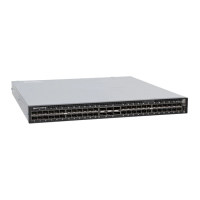iSCSI Optimization
This chapter describes how to configure internet small computer system interface (iSCSI) optimization, which
enables quality-of-service (QoS) treatment for iSCSI traffic. The topics covered in this chapter include:
• iSCSI Optimization Overview
• Default iSCSI Optimization Values
• iSCSI Optimization Prerequisites
• Configuring iSCSI Optimization
• Displaying iSCSI Optimization Information
Topics:
• iSCSI Optimization Overview
• Default iSCSI Optimization Values
• iSCSI Optimization Prerequisites
• Configuring iSCSI Optimization
• Displaying iSCSI Optimization Information
iSCSI Optimization Overview
iSCSI is a TCP/IP-based protocol for establishing and managing connections between IP-based storage
devices and initiators in a storage area network (SAN).
iSCSI optimization enables the network switch to auto-detect Dell’s iSCSI storage arrays and triggers a self-
configuration of several key network configurations that enables optimization of the network for better
storage traffic throughput. iSCSI is disabled by default.
iSCSI optimization also provides a means of monitoring iSCSI sessions and applying quality of service (QoS)
policies on iSCSI traffic. When enabled, iSCSI optimization allows a switch to monitor (snoop) the
establishment and termination of iSCSI connections. The switch uses the snooped information to detect iSCSI
sessions and connections established through the switch.
iSCSI optimization allows you to reduce deployment time and management complexity in data centers. In a
data center network, Dell EqualLogic and Compellent iSCSI storage arrays are connected to a converged
Ethernet network using the data center bridging exchange protocol (DCBx) through stacked and/or non-
stacked Ethernet switches.
iSCSI session monitoring over virtual link trunking (VLT) synchronizes the iSCSI session information between
the VLT peers, allowing session information to be available in both the VLT peers. You can enable or disable
iSCSI when you configure VLT.
iSCSI optimization functions as follows:
26
iSCSI Optimization 542

